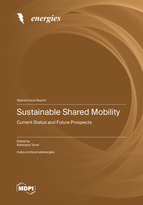Sustainable Shared Mobility: Current Status and Future Prospects
A special issue of Energies (ISSN 1996-1073). This special issue belongs to the section "E: Electric Vehicles".
Deadline for manuscript submissions: closed (15 March 2023) | Viewed by 9969
Special Issue Editor
Interests: shared mobility; car-sharing; bike-sharing; scooter-sharing; new mobility; electromobility; electric mobility; electric shared mobility; sustainable transport systems
Special Issues, Collections and Topics in MDPI journals
Special Issue Information
Dear Colleagues,
The sustainable shared mobility market is changing very rapidly. In recent years, a great number of car-sharing, bike-sharing, scooter-sharing, and moped-sharing operators have started their business, and at the same time, a large group of service providers have closed their shared mobility systems. There is a large disproportion between the operating systems, areas of their operation, fleet, and system equipment and their principles of operation. However, in connection with the trend of sustainable transport advancement, electromobility development and the need to change behavior in the mobility of society, there is a need for constant monitoring, improvement, and optimization of services operating in a shared mobility market. The current market turmoil, including the pandemic situation, is becoming an interesting research area in the field of changes taking place in shared mobility services.
This Special Issue is dedicated to the current status and future prospects of the sustainable shared mobility market. Due to the very wide range of topics related to shared mobility services, this Special Issue will be interdisciplinary. Any research that includes analysis of the existing practices of the functioning of shared mobility and shared electric mobility systems, developed mathematical, business, and descriptive models, calculations, forecasts, plans and development analyses, comparative analyses, advanced literature reviews, reviews, case studies, guidelines, and theoretical and practical studies are warmly welcome.
Dr. Katarzyna Turoń
Guest Editor
Manuscript Submission Information
Manuscripts should be submitted online at www.mdpi.com by registering and logging in to this website. Once you are registered, click here to go to the submission form. Manuscripts can be submitted until the deadline. All submissions that pass pre-check are peer-reviewed. Accepted papers will be published continuously in the journal (as soon as accepted) and will be listed together on the special issue website. Research articles, review articles as well as short communications are invited. For planned papers, a title and short abstract (about 100 words) can be sent to the Editorial Office for announcement on this website.
Submitted manuscripts should not have been published previously, nor be under consideration for publication elsewhere (except conference proceedings papers). All manuscripts are thoroughly refereed through a single-blind peer-review process. A guide for authors and other relevant information for submission of manuscripts is available on the Instructions for Authors page. Energies is an international peer-reviewed open access semimonthly journal published by MDPI.
Please visit the Instructions for Authors page before submitting a manuscript. The Article Processing Charge (APC) for publication in this open access journal is 2600 CHF (Swiss Francs). Submitted papers should be well formatted and use good English. Authors may use MDPI's English editing service prior to publication or during author revisions.
Keywords
- Shared mobility
- Electric shared mobility
- Electromobility
- Mobility management
- Sustainable transport
- Urban transport systems
- Mobility
- Transportation engineering. Car-sharing Scooter-sharing Bike-sharing Moped-sharing Kick-scooter sharing






